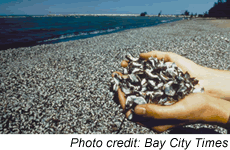 |
||||
Home > Research by Programs > AIS
Aquatic Invasive Species
Task Leader: David Reid
Highlights
Novirhabdovirus sp - Viral Hemorrhagic Septicemia (VHS) Factsheet
 Invasive Zooplankton
Bloody Red Mysid (Hemimysis anomala) Recently Discovered
Invasive Zooplankton
Bloody Red Mysid (Hemimysis anomala) Recently Discovered
National Center for Research on Aquatic Invasive Species GLERL hosts NOAA's National Center for Research on Aquatic Invasive Species (NCRAIS) at its Ann Arbor facility. The center will allow NOAA to more effectively organize and coordinate its aquatic invasive species research efforts while ensuring that NOAA resources are focused on nationwide priorities.
No Ballast On Board (NOBOB) Final Project Report
"Assessment of Transoceanic NOBOB Vessels and Low-Salinity Ballast Water
as Vectors for Non-Indigenous Species Introductions to the Great Lakes"
+ download
file [pdf] (8.3 Mb)
Current Featured Projects
 Micro-elemental
analysis of statoliths as a tool for tracking tributary origins of sea
lamprey
Micro-elemental
analysis of statoliths as a tool for tracking tributary origins of sea
lamprey
The analysis of otolith micro-elemental composition has been a valuable
tool for differentiating between local spawning populations, and identifying
origins of recruits to the fishery. Building on two pilot investigations
conducted in lakes Champlain and Huron, we will determine whether trace
elements incorporated into sea lamprey statoliths during larval stream
residence can be used to discriminate among local populations in Lake
Huron.
+ Read more
 Assessment
of Transoceanic No-Ballast-On-Board (NOBOB) Vessels and Low-Salinity Ballast
Water as Vectors for Nonindigenous Species Introductions to the Great
Lakes Project
Assessment
of Transoceanic No-Ballast-On-Board (NOBOB) Vessels and Low-Salinity Ballast
Water as Vectors for Nonindigenous Species Introductions to the Great
Lakes Project
90% or more of the overseas vessels that enter the Great Lakes are characterized
as "NOBOB" ("no-ballast-on-board"), yet their ballast tanks contain small
amounts of residual ballast water and sediment, as well as live aquatic
organisms accumulated over numerous previous ballasting operations. This
project, started in late 2000 and completed in April 2005, was the first
significant biological characterization and invasive species risk assessment
of NOBOB ballast tanks. The project also studied the effectiveness of
ballast water exchange on removing or killing coastal organisms.
+ Read more
Complete Listing of GLERL Aquatic Invasive Species Program Projects
Data products
Great Lakes Aquatic Nonindigenous Species Information System Database
Great Lakes Aquatic Nonindigenous Species List
This list was compiled by the NOAA National Center for Aquatic Invasive
Species Research at GLERL.
+ Read more
Conversion of specific gravity to salinity for ballast water regulatory management. NOAA Technical Memorandum GLERL-139. Reid, D.F. (2006) .NOAA Great Lakes Environmental Research Laboratory, Ann Arbor, MI, 24 pp.
+ Read more [PDF]
Physical and Chemical Variables of Saginaw Bay, Lake Huron in
1991-1993. NOAA Technical Memorandum TM-091, Nalepa et al. (1996).
Chlorophyll, nutrients, alkalinity, carbon, and total suspended solids
data collected in Saginaw Bay, Lake Huron from 1991-1993.
+
Read More [PDF]
Complete Listing of GLERL Data Products
Selected Software products
EcoNetwrk software
A Windows-compatible tool to analyze ecological flow networks; available
for download.
+ Read more
Complete Listing of GLERL Software Products

Program Background
The Great Lakes basin is the aquatic gateway to the heartland of America and a national hot spot for aquatic invasive species (AIS) introductions that can reach other sections of the U.S. Records of aquatic species invasions in the Great Lakes start in the early 1800s. By 2005 at least 182 AIS have been reported in the Great Lakes, with more than 40% discovered since 1960. The rate of discovery since 1960 has not been linear, but for illustrative purposes, can be said to average about one new invader every 28 weeks. Nonindigenous species are now a significant component of most trophic levels in the Great Lakes.
GLERL's research on invasive species targets two key issues: 1) The prevention of new invasive species introductions and 2) The understanding of the biological and ecological impacts of nonindigenous species in the Great Lakes.
Recent Publications
POTHOVEN, S. A., and C. P. Madenjian. Changes in consumption by alewives and lake whitefish after Dreissenid mussel invasions in Lakes Michigan and Huron. North American Journal of Fisheries Management 28:308-320 (2008).
+ download article [pdf]
Gray, D. K., T. H. JOHENGEN, D. F. REID, and H. J. MacIsaac. Efficacy of open-ocean ballast water exchange as a means of preventing invertebrate invasions between freshwater ports. Limnology and Oceanography 52(6):2386-2397 (2007).
+ download article [pdf]
PANGLE, K.L., S.D. PEACOR, and O.E. Johansson. Large nonlethal effects of an invasive invertebrate predator on zooplankton population growth rate. Ecology 88(2):402-412 (2007).
+ download article [pdf]
+ Complete Listings of GLERL Publications
Selected Brochures
Exotic, Invasive,
Alien, Nonindigenous, or Nuisance Species: No matter what you call them,
they're a growing problem
+ download brochure [PDF]
Aquatic Invasive Species
and the Great Lakes: Simple Questions, Complex Answers
+ download brochure [PDF]

